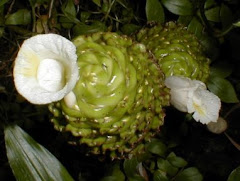
ACTIVE PRINCIPLES
Zingerone, shogaols, gingerols and volatile oils that compose about one to three percent of the weight of fresh ginger. In laboratory animals, the gingerols increase the motility of the gastrointestinal tract and have analgesic, sedative, antipyretic and antibacterial properties.
Ginger contains up to three percent of a fragrant essential oil whose main constituents are sesquiterpenoids, with (-)-zingiberene as the main component. Smaller amounts of other sesquiterpenoids (β-sesquiphellandrene, bisabolene and farnesene) and a small monoterpenoid fraction (β-phelladrene, cineol, and citral) have also been identified.
The pungent taste of ginger is due to nonvolatile phenylpropanoid-derived compounds, particularly gingerols and shogaols, which form from gingerols when ginger is dried or cooked. Zingerone is also produced from gingerols during this process; this compound is less pungent and has a spicy-sweet aroma. Shogaols have recently been found to be twice as pungent as gingerols.
Ginger is also a minor chemical irritant, and because of this was used as a horse suppository by pre-World War I mounted regiments for figging.
Ginger has a sialagogue action, stimulating the production of saliva, which makes swallowing easier.
COLOUR & APPEARANCE
Yellowish brown or light brown. Scraped rhizome with buff external surface showing longitudinal striations and occasional loose fibers, outer surface dark brown and more or less covered with cork which shows conspicuous, narrow, longitudinal and transverse ridges.
ODOUR
Aromatic, Refreshing, Lemon-like smell
TASTE
Sharply Pungent, moderately burning or warm taste and sweet
HEAT SCALE
7































































No comments:
Post a Comment